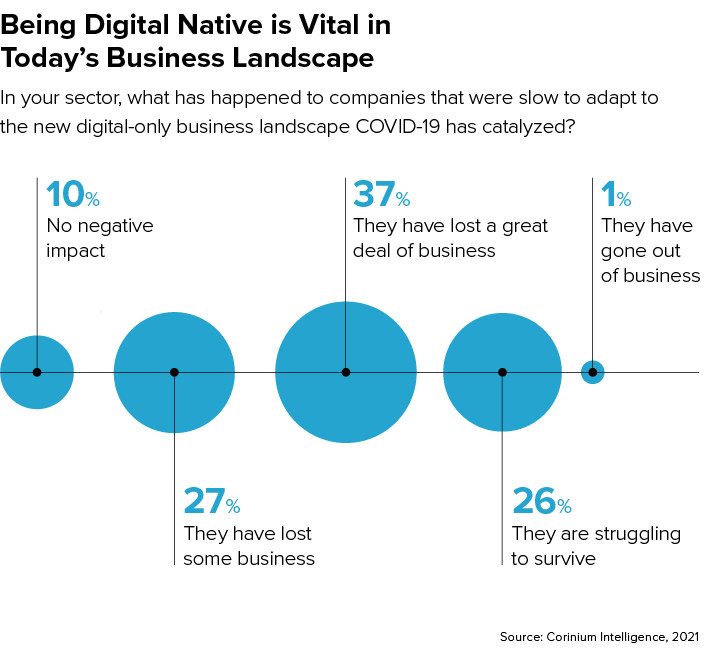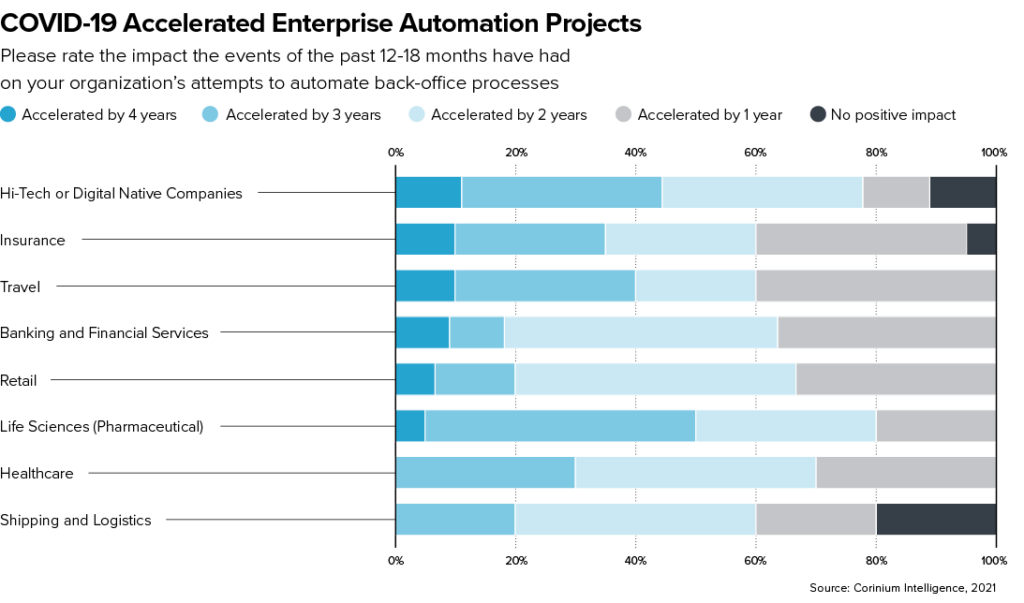How the World Went Digital-Only

COVID-19 did more than accelerate digital transformations across the globe. It catalyzed a fundamental shift toward 'digital-only' business processes
The legacy of COVID-19 on businesses will be about more than Zoom meetings and remote working. This pandemic has catalyzed a fundamental and permanent shift in the way people do business.
From shifts in consumer preferences in the car and property sectors to the transition of IT architectures to the cloud and infusion of AI into back-office processes, enterprise leaders say there is no going back when it comes to the changes wrought by the crisis.
Our latest survey of 100 global digital transformation leaders shows that enterprises that were slow to pivot their plans toward 'digital-only' as lockdowns and other restrictions disrupted their operations paid a heavy price.

More than a quarter of those who failed to adapt in time are struggling to survive, and just under 1% have gone bust. Another 37% lost a lot of business, while 27% lost some business. Only 10% of those who didn’t react swiftly to the crisis saw no negative impact as a result.
“There’s been a lot of focus on helping those who are not digital to adopt digital,” says Nino Ocampo, Global Head of Open Banking and Customer Preferences at HSBC. “We see this as an opportunity for us to focus on simplifying access to our digital features and improving digital engagement capabilities.”
Many companies, especially the likes of Amazon, have thrived in the new online-only business environment. But as enterprises start to re-imagine what their businesses will look like in a post-pandemic world, the big question is: How many of these pandemic-era innovations are here to stay?
COVID-19 Accelerated Digital Transformation Trends
Transitioning to ‘digital only’ has come naturally for some and brought big benefits. Some enterprises that used the pandemic to speed up a range of digital transformation initiatives are reporting that they are now five years ahead of where they would otherwise be.
“One of our biggest achievements for the last 12 months is being 100% in the cloud,” says El Diawlol, Director of Advanced Analytics at commercial lending platform Genesis Capital. “All our models are deployed in the cloud and we’re able to manage the team remotely. At the beginning, that was a little bit challenging. But for the last six months, everything is stabilizing.”
Many others have made similar progress. Some 30% say the pandemic has accelerated the migration of data, applications and services to the cloud by a year. Just over 17% are two years ahead, while more than 40% are 3-4 years ahead of where they would otherwise be.

Progress in the automation of back-office business processes has been more profound: 97% of respondents say they are now ahead of schedule on this front, with 35% shaving at least three years off their timetables.
Client-facing processes were rapidly digitized, too. More than two thirds expedited things in this area by up to two years, and a quarter accelerated this transformation by 3-4 years.
These findings show the pandemic has primarily fast-tracked existing industry trends, rather than spawning new ones.
In the automotive industry, the shift to working from home and global restrictions on travel have accelerated one disruptive trend that could see consumers move away from traditional car ownership models.
“For more and more people, the idea of owning a car is changing,” says Gabriele Compostella PhD, CTO at Volkswagen Data Lab. “This transformation relates to the approach that people have towards mobility, which I think has been made even more dramatic or strange by the pandemic.”
Business Transformation in the Digital-Only ‘New Normal’
There is widespread acceptance that the events of the past two years have changed how global enterprises operate forever. None of the executives we surveyed expect to resume business as usual after the pandemic is over.
A full 52% of respondents plan to maintain their new online presence while restoring pre-pandemic, in-person operations, while 15% say they will slim down their in-person operations and continue to prioritize digital.
The remaining third will aim to maintain their new online presence while growing their in-person operations beyond pre-pandemic levels.
“What we're seeing from a trend perspective is certainly customers moving away from the traditional banking methods,” says Zeb Drummond, Gateway Bank’s Head of Customer Operations.
“People are much more comfortable in digital mediums, where previously they might've approached us in our branch or have called us on the phone”
Zeb Drummond, Head of Customer Operations, Gateway Bank
The rise of flexible working is another concrete example of a pandemic-era innovation that will leave a permanent mark on the business landscape.
Nobody we spoke to plans to resume 100% office-based working, while 40% say they will offer flexibility to employees to work from home while maintaining mostly office-based work. Another 40% will introduce hybrid models that blend remote working with a presence in the office. The rest will do away with offices altogether and go 100% remote.
“When COVID-19 hit first, many organizations were shocked,” Diawlol says. “They were actually thinking, ‘How are we going to operate in this environment?’ [But] many organizations were very surprised to see that most of their operations stayed operational. In terms of productivity, there wasn't a lot of loss.”
All this means it has never been more important for global enterprises to invest in digital transformation. The innovations that have helped businesses survive these trying times will continue to drive efficiency and productivity gains in the post-pandemic world.
While in-person meetings and interactions will no doubt return in the coming months, the era of digital-only is here to stay. In this new era, businesses that fail to phase out outdated analog processes will struggle to survive.
This is an excerpt from our Business Transformation After the Digital 'Tipping Point' research report. Click here now to discover more about how businesses are adapting to day's digital-only world.



.jpg?width=352&name=Copy%20of%20APAC%20Feature%20image_interviews_1920x1080px%20(1).jpg)